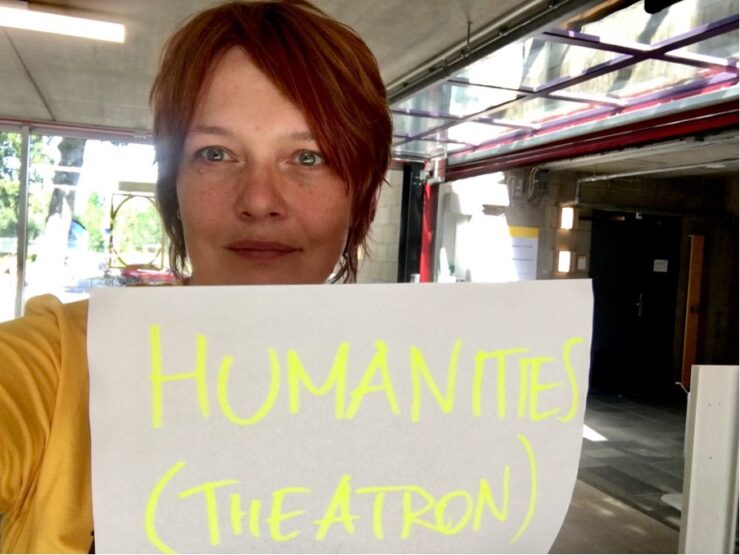News
Macarena in Junkspace An Object-Oriented Ontology of Architexturized Dance – Olga Efremov

“What if?” That is the question.
Once belonging to the realms of the speculative fiction writing craft, ‘what if’ question has been steadily earning recognition as a legitima
te mode of academic inquiry. According to Media, Arts and Performance scholar Theron Schmidt (2021), a speculative approach premised on the use of ‘what if’ is a familiar tactic within the discipline of theatre and performance studies. Rooted in the foundational texts on the concepts of performance, such as director Konstantin Stanislavski’s ‘magic if’, it invites an actor to behave realistically within the artificial parameters of a dramatic scene (346). This blog post is hence a ‘what if’ response to the challenge brought by Laura Karreman’s talk at the seventh session of TiM 2022-23 seminar series “Cultural Dreams of Datafied Bodies in Contemporary Performance” where she proposed the notion of ‘embodied computation’ to describe the role of embodied knowledge in making motion data speak. Using a dramaturgical perspective, Karreman argued that “motion capture of human movement needs to be understood as a site for performance that uses multiple strategies of staging” (Utrecht University 2023). I would like to accept her invitation to reimagine motion capture as an apparatus of motion creation and respond, in the sprit of a posthuman imaginary’s speculative mode of inquiry:
What if we think of Rem Koolhaas’ Educatorium as an ‘embodied computation’ site?
Built in 1995 as a part of Utrecht Science Park (then Uithof) campus development (OMA n.d.), Educatorium is not often visited by Humanities students apart from special occasions such as new students orientation event that in 2022-23 academic year took place in Theatron lecture hall, perhaps as an ironic coincidence (Picture 1). It would be safe to assume that not many of theatre and performance students ever ventured as far as the top of the stairs leading to the lecture hall to admire a wood-clad gallery space overlooking the university’s botanic gardens. Those who had invested their time and body into taking dance classes in an appropriately equipped studio would immediately recognize the ‘embodied’ resonance of a dance floor: an invitation to move and to “give joy to your body” as urges the refrain from the 1990s dance hit “Macarena”. It is this wooden floor space that encouraged me to revisit the concept of “architexture” introduced by Lisbeth Groot Nibbelink in her book Nomadic Theatre: “a fabric of intersecting spaces and perspectives, which reveals the live event as staged through scenography” (2019, 144). The architexture of Educatorium’s liminal space reveals itself only to those in possession of the embodied knowledge of dance performance training; it makes me wonder how many thought of this gallery as a clandestine dance studio, with the reflective wall of Theatron lecture hall as a mirror. And of those who did, how many would see this space as a “nomadic theatre” site for a motion capture performance?

Picture 1. Humanities students are guided through Educatorium at 2022-23 orientation event.
What if these kinds of accidental revelations that emerge in the process of “intra-actions” (Barad 2006, 139) between human and non-human bodies are the exact tools needed for exploring the emerging branches of new materialism theories, such as Graham Harman’s object-oriented ontology (2018, 7)? What if we look diffractively at Koolhaas’ architextural concept of “junkspace” (2002, 175) through Harman’s lens of speculative realism? What if we see the dance floor, not the dancer, as the main focus of motion capture study that can reveal posthuman, object-oriented perspectives on contemporary performance? In his 2022 book Architecture and Objects Harman argues that “work in every discipline, including […] architecture, works under a monumental imperative”, meaning it should stive “to be more than the product of its time and place” (174). Perhaps if we apply this idea of monumental imperative to the notion of ‘embodied computation’ imaginary, even junkspace can dance.
References
Barad, Karen. 2006. “Agential Realism: How Material-Discursive Practices Matter.” In Meeting the Universe Halfway: Quantum Physics and the Entanglement of Matter and Meaning, 132–85. Durham: Duke University Press. https://doi.org/10.1215/9780822388128-005.
Groot Nibbelink, Liesbeth. 2019. Nomadic Theatre: Mobilizing Theory and Practice on the European Stage. London: Bloomsbury.
Harman, Graham. 2018. Object-Oriented Ontology. London: Penguin.
———. 2022. Architecture and Objects. Minneapolis: University of Minnesota Press.
Koolhaas, Rem. 2002. “Junkspace.” October 100 (April): 175–90. https://doi.org/10.1162/016228702320218457.
OMA. n.d. “Educatorium.” OMA. https://www.oma.com/projects/educatorium.
Schmidt, Theron. 2021. “What If We Think of the Classroom as a Work of Art? Performance, Collaboration, and Social Engagement Considered as Pedagogic Practices.” Arts and Humanities in Higher Education 20 (4): 345–64. https://doi.org/10.1177/1474022220966944.
Utrecht University. 2023. “Cultural Dreams of Datafied Bodies in Contemporary Performance” – Laura Karreman (UU).”Transmission in Motion. Accessed April 16, 2023. https://transmissioninmotion.sites.uu.nl/cultural-dreams-of-datafied-bodies-in-contemporary-performance-laura-karreman-uu.
Images:
Efremov, Olga. 2022. Welcome to Junkspace. Moerdyke Creative Writing [MCW] Lab. https://ic.pics.livejournal.com/moerdyke/9393129/2031640/2031640_1000.jpg.
———. 2023. Educatorium Revisited. Moerdyke Creative Writing [MCW] Lab. https://ic.pics.livejournal.com/moerdyke/9393129/2095102/2095102_800.jpg.

